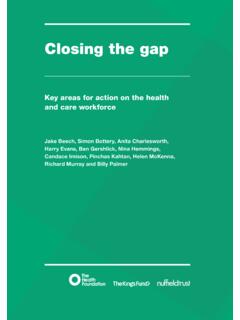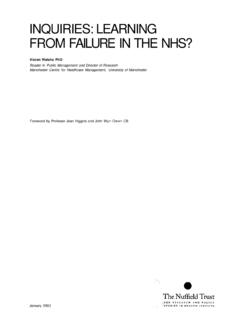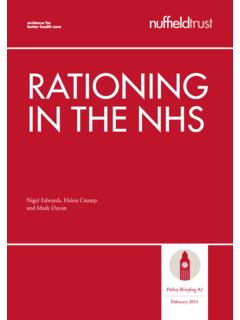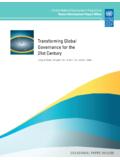Transcription of Introducing Market Forces into Health Care: A Tale of Two ...
1 Introducing Market Forces into Health Care: A Tale of Two Countries Alain C. Enthoven Marriner S. Eccles Professor of Public and Private Management (Emeritus) Graduate School of Business Stanford University Presented at the Fourth European Conference on Health Economics Paris,July l0,2002 Alain C. Enthoven Applications for reproduction should be made to The Nuffield Trust 59 New Cavendish Street London W1M 7RD The Nuffield Trust The Nuffield Trust for research and policy studies in Health services was established by Viscount Nuffield in 1940.
2 Today the Trust acts as an independent commentator on the UK Health scene and the National Health Service. It has set out to illuminate current issues through informed debate, meetings and publications; and has also commissioned research and policy studies aimed at the development of policy and improvement of Health services. Address: 59 New Cavendish Street, London W1M 7RD UK Tel: 020 7631 8450 Fax: 020 7631 8451 Email: Internet: ISBN: 1 90 208970 7 Printed in the United Kingdom for the Stationery Office.
3 Foreword by John Wyn Owen In 1999 Alain Enthoven was the Nuffield Trust's Rock Carling Fellow and presented a lecture entitled In pursuit of an improving NHS which the Trust subsequently published. This Fellowship followed Professor Enthoven's earlier work for the Trust in 1985, which culminated in the publication of Reflections on the Management of the NHS. The Nuffield Trust is publishing this latest lecture by Professor Enthoven as a further contribution to an understanding of the impact of Market reforms in both the United Kingdom and the United States.
4 He makes some interesting observations on the continuity of the reform process in the UK in spite of the change of government in 1997. The NHS is at a critical point in its history and must now rise to the challenge set by the current government which has backed the service with significant increased investment at the last budget. The twin imperatives of meeting increased patient expectations and the demand for more choice in healthcare will not go away, while increasing quality and safety of Health care delivery remains paramount.
5 Professor Enthoven argues that managed Market competition is the best and possibly only way to achieve this both in the UK and the US . By Market Forces he means 'significant responsible consumer choice among providers, and providers who gain their incomes from serving the consumers who choose them.' However he designates the 'creation of a Market in healthcare that drives improvement a particularly complex undertaking.' It cannot be achieved without 'information on quality and cost; purchasers with incentives to seek value for money and freedom to buy selectively; providers capable of responding to Market Forces ; a pro-competitive regulatory framework; a capital Market ; and a careful sorting out of what can and cannot be left to the Market .
6 ' The opportunities and challenges that lie ahead in improving the NHS are enormous and the aggregated learning available to us from both the NHS Reforms of the 1980s and 1990s and from the United States are important sources of knowledge to help in the task ahead. John Wyn Owen CB Secretary The Nuffield Trust July 2002 Introducing Market Forces INTO Health CARE: A TALE OF TWO COUNTRIES 3 4 Introducing Market Forces INTO Health CARE: A TALE OF TWO COUNTRIES Introduction I have worked to introduce Market Forces into two Health care systems in an attempt to create incentives for providers to innovate in ways that improve outcomes, including patient satisfaction, and reduce costs.
7 By Market Forces , I mean significant responsible consumer choice among providers, and providers who gain their incomes from serving the consumers who chose them. In this lecture, I briefly summarize what happened, and offer some reflections on the experience. Introducing Market Forces INTO Health CARE: A TALE OF TWO COUNTRIES 5 The British National Health Service In 1985, I wrote: "The NHS is caught in the grip of Forces that make change exceedingly difficult to bring about, a 'gridlock' of its Managers have no powerful incentive to make efficiency-improving changes.
8 In fact there are many disincentives to 'rocking the boat.'" I went on to suggest "an internal Market model for the NHS" in which District Health Authorities would be re-cast as purchasers of Services on behalf of their populations, and not mere conduits of directives and money from above to providers. Purchasers would be free to buy what they considered to be the best services for their patients, from wherever supplied within the NHS. They would be paid for services they provide to others' patients. Managers would be freed from massive amounts of central directives, and held responsible for the overall results they achieve.
9 Criticism of the organization of the NHS is no longer viewed as a partisan matter. This year, Alan Milburn, Secretary of State for Health , said of the NHS: "While its values are right, its structures are wrong.. Patients are disempowered with little if any choice. The system seems to work for its own convenience not the patient's a frustration that is shared by patients and staff alike. The whole thing is monolithic and fifty years, the structure of the NHS meant that governments both Labour and Conservative - defended the interests of the NHS as a producer of services when they should have been focused on the interests of patients as the consumers of services.
10 " Fundamental change in this structure began in January 1989, when the Thatcher government published Working for Patients, a strategy for reforming the NHS based on increased local responsibility, patient choice, and competition. Key elements included "the purchaser-provider split" in which District Health Authorities would be re-cast as purchasers, not providers; self-governing NHS Hospital Trusts that would earn revenue from the services they provide and would operate with greater independence; "General Practitioner ( ) Fundholders," large practices that could take responsibility for an increased budget with which to buy elective hospital and other services.











